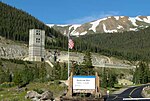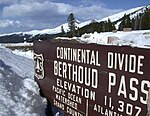Engelmann Peak

Engelmann Peak is a high mountain summit in the Front Range of the Rocky Mountains of North America. The 13,368-foot (4,075 m) thirteener is located in Arapaho National Forest, 6.3 miles (10.2 km) west by south (bearing 261°) of the Town of Empire in Clear Creek County, Colorado, United States. The mountain was named in honor of the botanist George Engelmann.The mountain is named for George Engelmann (1809-1884) a famous botanist responsible for describing and naming flora in the Rocky Mountains. He was born and educated in Germany and received his medical degree there. In 1832, he sailed to America. His financial backing had come from relatives in Germany who wanted him to invest in the lands of the new country so he explored areas in Illinois, Missouri and Arkansas.
Excerpt from the Wikipedia article Engelmann Peak (License: CC BY-SA 3.0, Authors, Images).Engelmann Peak
Geographical coordinates (GPS) Address Nearby Places Show on map
Geographical coordinates (GPS)
| Latitude | Longitude |
|---|---|
| N 39.7455426 ° | E -105.8005636 ° |
Address
Clear Creek County (Clear Creek)
Colorado, United States
Open on Google Maps









